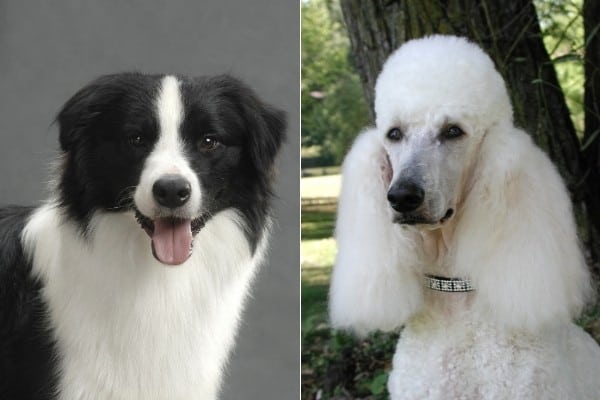
With so many designer dogs around today, it can be hard to keep up with what’s what, especially when it comes to the ever-popular Doodle dogs.
If you’re wondering what in the world a Bordoodle is, you’re not alone.
What is a Bordoodle? A Bordoodle is a perfect combination of the hard-working, supremely intelligent Border Collie and the effervescent, friendly Poodle. Bordoodles are typically 35 – 50 pounds with long, wavy coats in a huge variety of colors and are gentle and playful.
Border Collies often prove to be too much to handle unless they are allowed to work as they were bred to do.
Poodles make fabulous pets and are held in high regard for their nonshedding coat, but many people find them a little too prissy.
Combine these two breeds, however, and you have a dog like no other.
In the following, we’ll explore all aspects of this adorable mix to see if the Bordoodle just might be the dog of your dreams.
Bordoodles At a Glance
Gentle, energetic, and sociable, Bordoodles tend to exhibit only the most desirable traits from the parent breeds.
This Border Collie Poodle mix is a fairly new addition to the designer-dog world, but with the affectionate, fun-loving, sweet temperament the crossbreed consistently exhibits, he’s sure to rapidly rise in popularity.
Also known as a Borpoo, Bordadoodle, Borderdoodle, Borderpoo, and Border Poodle, the Bordoodle looks like a huge teddy bear and is as cuddly as one too.
| Origin | Border Collie and Poodle |
| Height | Standard: 18 – 20 inches, Miniature: approx. 15 inches |
| Weight | Standard: 35 – 50, Miniature: 20 – 35 |
| Varieties | Standard, Moyen, Miniature |
| Colors | Numerous colors and patterns |
| Coat | Wavy to curly |
| Temperament | Affectionate, playful, |
| Good for families? | Excellent |
| Good with other dogs? | Yes |
| Excessive barking? | No |
| Energy level | Fairly high |
| Exercise needs | At least 45 minutes daily |
| Health conditions | Common issues in parent breeds are possible |
| Life expectancy | 12 – 15 years |
What Does a Bordoodle Look Like?
While many first-generation mixed litters often have puppies who strongly favor one parent or the other, Bordoodles tend to be born with their own unique look.
The strong facial features of the Poodle are softened as is the powerful, muscular frame of the Border Collie to create a perfect blend of features.
Bordoodles look like overgrown teddy bears with long legs and alert, intelligent eyes.
The coat is typically long, soft, and wavy, though some Bordoodles may have a curlier coat depending on generation and genetics.
Bordoodle Size
The majority of Bordoodles come from a Border Collie and a Standard Poodle, although some breeders may occasionally use a Miniature Poodle, a Moyen Poodle (learn about the Moyen variety here), or even a Toy Poodle to produce smaller Bordoodles.
Of course, Bordoodles with a Standard Poodle parent will be the largest variety.
Bordoodle Height
The majority of Bordoodles will be between 18 – 20 inches tall, though this only applies to Standard Bordoodles, and some will fall outside this range.
Miniature or Medium Bordoodles (depending on the breeder’s choice of terms) are shorter, often around 15 inches tall.
Bordoodle Weight
Standard Bordoodles typically weigh 35 – 50 pounds, though some may be closer to 65 pounds, depending on the size of the Poodle parent.
Mini or Medium Bordoodles commonly weigh 20 – 35 pounds, though this can vary greatly based on the Poodle used in breeding.
What Is a Mini Bordoodle?
Most breeders use the term Mini Bordoodle to refer to a Bordoodle resulting from a Border Collie to Miniature or Moyen Poodle pairing.
This variety can vary in size but is typically 20 – 35 pounds.
Keep in mind that some breeders may use a Toy Poodle to create a really small Bordoodle and refer to the offspring as Miniature Bordoodles, though this is rare.
Be sure to ask the breeder about both parent dogs if you are wanting a specific size Bordoodle.
What Is a Standard Bordoodle?
The term Standard Bordoodle refers to the largest variety available, created from a Border Collie and Standard Poodle.
Standard Bordoodles are currently the most common and are what most people are speaking of when referring to Bordoodles.
They are typically about the same weight as Border Collies, about 35 to 50 pounds, but they’ll often be taller due to the Poodle’s height.
Bordoodle Generations
Most of the Bordoodles produced are first-generation pups, or F1 for short.
This means that one parent was a purebred Border Collie and the other parent was a purebred Poodle.
An F1 Bordoodle bred to a Poodle will result in a first-generation backcross (F1b).
An F1 could be bred to a Border Collie to also produce an F1b, but this isn’t done very often because it’s the addition of more Poodle genes to the line that enhances desirable features, such as low shedding and cheerful disposition.
Second generation Bordoodles (f2) are the result of the pairing of either two F1s or an F1 and an F1b.
Generations produced beyond these would be termed F3, F3b, F4, and so on, but they are often simply referred to as multigens.
Here’s a breakdown of the different generations and traits usually seen in the puppies.
- F1 – Border Collie x Poodle – coat will vary between wavy and loosely curled (often called a fleece coat); shedding will vary from low to moderate.
- F1b – Bordoodle x Poodle – coat will be curlier, denser, and lower shedding (often called a wool coat).
- F2 – F1 x F1 or F1 x F1b – coat can vary from fleece to wool type but is typically very low shedding.
- Multigen – puppies from F2 pairings and beyond – not commonly done, so little is known about the coat possibilities, though very low shedding coats would be expected.
Though allergy-friendly coats are possible with each generation, generally an F1b is the best choice for allergy sufferers.
Bordoodle Colors
Bordoodles have an impressive amount of color possibilities including but not limited to:
- Black.
- Chocolate.
- Blue.
- Lilac.
- Red.
- Apricot.
- Cream.
- Tan.
- Silver.
- Fawn.
- Gold.
- Seal.
- Slate.
- Cafe au lait.
Numerous combinations of colors are possible in bicolor and tricolor Bordoodles as well as beautiful markings such as brindle, merle, tan points, Irish spotting, abstract, and ticking.
Do Bordoodles Change Colors?
Because many Bordoodles have what’s known as the fading gene (common in Poodles), darkly colored dogs may become lighter with time.
Rich black may fade to a silvery sheen, and chocolate may fade to a very light tan. Conversely, some colors, such as cream, will darken as the puppy matures.
Some colors, such as red, can go either way, becoming deep and rich or fading to apricot. It just depends on the genetic makeup of the puppy.
Bordoodle Coat
Many Bordoodles will have a soft coat full of gentle waves. These wavy coats will vary in terms of shedding.
Others will have slightly curlier coats that will only shed lightly, and those with a heavier concentration of Poodle genes may have tightly curled coats that have a coarser texture but will shed very little.
Bordoodle Temperament
A well-bred Bordoodle will be gentle, loving, sociable, highly intelligent, and incredibly eager to please.
Bordoodles thrive when given lots of attention and will reward your efforts with exceptional devotion.
This cheerful mix is wonderful with children and is a perfect fit for active families.
While some Bordoodles may retain some of the Border Collie’s herding instincts, it’s usually to a much lower degree and can be controlled with training.
Are Bordoodles Good Family Dogs?
Bordoodles are excellent for families of all sizes.
They love companionship and just being with people in general, so whatever family activity happens to be taking place, they’re up for it.
They are usually quite tolerant of young children’s antics and are known for their gentleness and love of play.
Are Bordoodles Affectionate?
Bordoodles are very loving and affectionate. In fact, many owners report that their Bordoodles still try to curl up in their laps for snuggles even after they are fully grown!
Sharing affection with their families comes naturally to these sweet-natured mixes, and they are incredibly loyal to those they love, but they may be shy or aloof when first meeting strangers.
Are Bordoodles Aggressive?
Aggression should not be an issue in any Bordoodle who has been correctly socialized and raised in a loving manner.
Our Complete Guide to Socialization (with included checklist) walks you through the process so that you can raise your Bordoodle to never feel the need for aggression as he will be confident, comfortable, and well behaved in every situation.
Are Bordoodles Stubborn?
A well-raised, properly trained Bordoodle is highly unlikely to exhibit stubbornness. As dogs are naturally pack animals, they instinctively desire a leader.
It is critical that an owner gains the trust of a Bordoodle by confidently fulfilling the role of leader.
If not, a Bordoodle, like any other dog, will step into this position himself and attempt to “lead the pack,” resulting in behavior that may be misconstrued as stubbornness.
Are Bordoodles Good With Other Dogs?
Bordoodles generally are friendly and playful with other dogs, especially those in the same household.
Meetings with a new dog should always be supervised in case any aggression should arise, but negative responses are more likely to come from the other dog rather than the friendly Bordoodle.
Are Bordoodles Good With Cats?
Many Bordoodles will get along very well with cats, particularly if they are introduced to felines while young.
Some of the best breeders will ensure this is done before the puppies leave for their new homes.
However, some Bordoodles will delight in chasing cats and may even kill them if not socialized properly or they have an unusually strong herding instinct.
How Much Do Bordoodle Puppies Cost?
Prices for a Bordoodle puppy can vary significantly, but $1,200 – $2,000 is the typical range, though some from exceptional breeders working to standardize this crossbreed may be more than $3,000.
Puppies aren’t always available, and breeders often have deposits on upcoming litters before they are even conceived, so the wait for a Bordoodle puppy may be as long as one year or more.
Here are some actual prices so you’ll have a clear idea of what to expect.
| Breeder | Location | Type | Price |
| Oregon Bordoodles | Oregon | F1, F1b, F2, F2b, F3
Standard, medium, moyen, miniature |
$3,500 |
| Mountain Rose Bordoodles | Utah | F1 and F1b
Standard, medium |
$3,500 |
| Creekside Doodles | Illinois | F1 and F1b
Standard |
$1,500 |
| Turk Family Farm | Ohio | F1 and F1b
Standard |
$2,000 |
| Willow Wind Doodles | Mississippi | F1 and F1b
Standard |
$1,800 |
Bordoodle Energy Level
Border Collies were bred to have high energy so that they could effectively do their jobs. Poodles are active too, though not quite to the same extent.
Bordoodles are typically moderately energetic, requiring a minimum of 45 – 60 minutes of exercise each day.
For this mixed breed, a large, fenced yard is ideal as they love playing outdoor games, like fetch, and running around with the kids, but a couple of vigorous walks each day will satisfy their exercise needs too.
Are Bordoodles Hyper?
While Border Collies are often described as being hyperactive, Bordoodles are not. This is due to the balancing effects that the Poodle brings to the mix.
Make no mistake, Bordoodles are energetic, but when given adequate daily exercise, they are calm and a pleasure to be around.
Some owners describe them as having an on/off switch, meaning that it’s full speed ahead when playing outdoors but as soon as they come inside, it’s time to conk out at your feet for a snooze.
Bordoodle Intelligence
There is no doubt that the Bordoodle has superior intelligence.
While this is definitely an advantage when training, it also means that he can become bored when not given plenty of opportunities to put those brains to work.
Providing lots of mental stimulation in creative ways (read this for ideas) will help ensure that destructive behaviors don’t arise due to boredom.
Are Bordoodles Smart?

Border Collies and Poodles hold the #1 and #2 positions on breed intelligence surveys, so Bordoodles are naturally way above average in terms of intelligence.
Even trainers who are rather skeptical of mixed breeds are often blown away by the Bordoodle’s ability to learn quickly, retain the information, and think for themselves.
Are Bordoodles Easy to Train?
Bordoodles can be a joy to train. They are naturally intuitive and able to focus on tasks for a longer time than most breeds.
Learning comes easily to these super-smart pups, but it’s best to start obedience training and housebreaking as soon as you bring your new Bordoodle home.
Use positive, reward-based training methods, and you’ll be amazed at how quickly this mix catches on to new commands.
Do Bordoodles Bark a Lot?
Nuisance barking usually is not an issue with Bordoodles who receive plenty of physical activity, mental stimulation, and companionship each day.
Because of their large, deep chests, Bordoodles have a loud, deep bark, and they won’t hesitate to alert the family when they sense something is not quite right.
Can Bordoodles Be Left Alone?
Because Bordoodles are so people oriented and become very attached to their family, they may not fare well when frequently left alone for long periods.
However, when crate trained properly and gradually accustomed to alone time, some Bordoodles may adjust to working schedules if given the chance to exercise in the morning and after you return.
Having a friend, family member, or dog walker stop in at least once during the day can help dramatically.
Are Bordoodles Hypoallergenic?
No dog is 100% hypoallergenic; however F1 Bordoodles who inherit a Poodle-like coat and F1b Bordoodles are typically well tolerated by those with allergies.
Experienced breeders can often determine which puppies in a litter will be the most allergy friendly, so be sure to make your preferences known before selecting a puppy.
Bordoodle Grooming
Like all Doodle dogs, Bordoodles will need routine grooming to keep the coat free of tangles and looking nice.
Brushing every other day is standard practice for those with longer coats, but those kept in a short cut may get by with a thorough brushing once per week.
Other routine grooming practices include:
- Ear cleaning every couple of weeks with a cleanser designed for pets (I use this one on my own Doodles).
- Nail trimming once a month (these clippers with comfort-grip, no-slip handles are great).
- Full-body clip every six to eight weeks.
- Oral hygiene, including brushing teeth several times each week (this kit includes a toothbrush, dog-safe toothpaste, and a finger brush) and professional cleanings once a year.
Do Bordoodles Shed?
Some Bordoodles shed very, very little, much like a Poodle, and will be well tolerated by allergy sufferers.
Other Bordoodles may shed more heavily, but the shedding is unlikely to be as severe as with a purebred Border Collie.
Those with a heavier concentration of Poodle genes, such as an F1 bred back to a Poodle (F1b), and F2 and F3 generation Bordoodles will exhibit the lowest shedding.
Do Bordoodles Need Clipping?
Most Bordoodles have a wavy to curly coat that will become quite long when left to grow naturally.
The longer the coat, the more involved brushing becomes, and tangles and painful mats will be inevitable.
While some owners prefer the long, shaggy look, most opt to have the coat trimmed every six weeks or so to make grooming more manageable.
Trimming the hair around the eyes in between trips to the groomer may be needed to prevent irritation and impaired vision.
Bordoodle Grooming Styles and Haircuts
A standard puppy cut or teddy bear cut looks adorable on Bordoodles regardless of coat type, and you can specify to your groomer what length you would prefer.
If you like, ask the groomer to leave in place and accentuate the furnishings, which are the longer portions of hair on the eyebrows, mustache, and beard, so there will be no doubt that your pup is a Doodle dog.
(Head over to our Doodle Dog Grooming Supply List to be sure you have everything needed if you think you’d like to skip the professional groomer.)
Bordoodle Health Problems
Bordoodles seem to be an exceptionally healthy mixed breed, though since they are relatively new, time will tell if they have higher-than-average predispositions to certain health conditions.
Theoretically, they could suffer from any condition commonly seen in Border Collies and Poodles, such as:
- Progressive retinal atrophy.
- Cataracts.
- Heart disease.
- Hypothyroidism.
- Epilepsy.
- Hip dysplasia.
- Portosystemic shunt.
- Cancer.
- Von Willebrand’s disease.
Bordoodle Life Expectancy
Since the Bordoodle has only been actively bred for about a decade, a specific life expectancy would, at this point, be merely an educated guess.
The Poodle’s lifespan is typically between 10 and 18 years, and most Border Collies usually live for 12 to 15 years, so a Bordoodle can be expected to enjoy a long life somewhere in this range.
Is a Bordoodle Right for Me?
A Bordoodle may be the ideal dog for you if you:
- Want a super intelligent, active, kid-friendly dog with a cheerful disposition.
- Love the focus and energy of the Border Collie but admire the spunk, willingness, and friendliness of the Poodle.
- Don’t mind moderate grooming.
- Enjoy an active lifestyle and are at home most days.
- Want a dog who is easy to train and a delight to live with.
Consider another breed if you:
- Are routinely away from home.
- Don’t enjoy being outdoors.
- Are looking for a guard dog.
- Are not willing to regularly exercise your dog’s body and mind.
Related Questions:
Do Bordoodles Like to Swim?
Believe it or not, the Poodle was originally used extensively for duck hunting and is a natural swimmer, so it’s no surprise that most Bordoodles love to swim too.
Other than bathtime, most Bordoodles will enjoy water in any form: kiddie pools, ponds, sprinklers, lakes, and even the ocean.
Though written with Goldendoodles in mind, this article has some excellent swimming safety tips applicable to any breed.
Are Mixed Breeds Healthier Than Purebreds?
Hybrid vigor, or heterosis, is a phenomenon often seen in mixed-breed dogs and refers to the fewer occurrences of common diseases and overall better health.
While the validity of hybrid vigor is often debated, the general consensus is that because of the larger gene pool available when combining separate breeds, the odds of puppies being homozygous for genetic diseases is greatly decreased.
Source:
https://www.sciencealert.com/smartest-dog-breeds-canine-psychologist-intelligence-pets
Last update on 2024-04-18 at 19:01 / Affiliate links / Images from Amazon Product Advertising API







